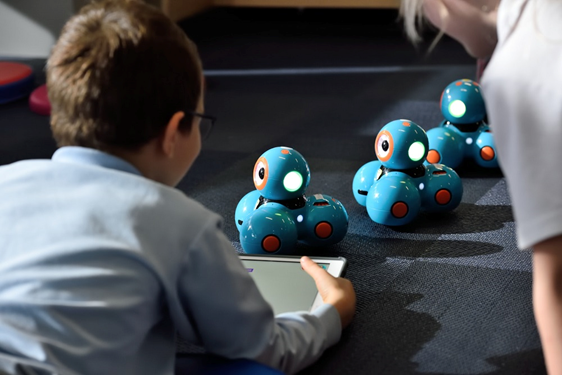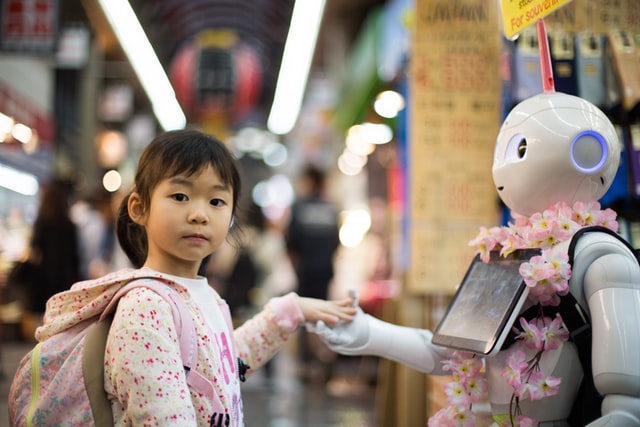By Xavier James
 Image source: https://unsplash.com/photos/rSdkzkfvqlY
Image source: https://unsplash.com/photos/rSdkzkfvqlY
Even though the technology is becoming increasingly important in the four walls of the classroom, students often tend to shy away from learning the basics. The apparent complexity of structures and the subject itself seems to overwhelm their learning instincts.
However, as responsible leads of today, it is our responsibility to convey the advanced technological knowledge to younger ones. But, of course, that wouldn't be possible until we realize the true impact of this knowledge upon kids.
For this very reason, this post aims to help you get acquainted with how exactly and what exactly young kids learn with robots. Let's get straight into it.
Role of Robots in Your Child's Learning Process
To understand the impact of robots or robotics on your child’s learning process, you need to understand what the term robot truly represents. Fundamentally, a robot refers to a mechanical device that abides by a set of instructions. It may or may not be able to interact with the environment.
When a child gets exposure to the concept of robots and robotics, they witness a practical demonstration of the use of the knowledge they acquire. Hence, it fuels their will to learn. What’s more, they encourage the edge of curiosity and inquisitiveness too.
Thus, summing up, exposure to working technology as well as access to making things work gives birth to a positive learning experience. As science says, robots are not capable of commenting. They assist the learning process by providing a carefree and encouraging environment.
Boosts Creativity
Children learning in an environment with robotics and technology are much more capable of solving issues. Studying in a challenging atmosphere helps them increase their intellectual abilities and come up with newer solutions to issues.
Young children are much more curious about things. And, robotic environments only increase their curiosity levels. They are easily able to handle difficult and challenging things.
Consequently, the generation will grow to be much more efficient and skillful. They will be able to deal with problematic situations of the future smoothly, without falling out of balance.
Gives a Hands-on Experience
By providing young ones with one-to-one experience, robots and robotics provide long-lasting knowledge. Kids do not only read the text and engulf the gist of it to get through a mere exam paper only. Instead, they get to learn through practical experience, which brings about more permanent memories. And of course, a better learning experience. Programming robots also encourages independent and critical thinking.
As you provide them with hands-on experience with real electrical components and mechanical concepts, they can relate learned stuff with everyday life. Soon, you will watch them trying to figure out the mechanism of their mechanical toys, cars, or even the rustic ceiling fans. Hence, becoming more aware of their surroundings and gradually developing problem-solving skills for everyday life.
Prepare them for the Digital Age
Believe it, or not-the future belongs to robotics. All those sci-fi movies and cartoons we used to watch in our childhood are becoming reality day by day.
-
Robotic Avatar: Toyota developed Robotic Avatar, also called T-HR3, back in 2017. It is a humanoid robot that mimics the motion of a human operator. The purpose of these robotic avatars to increase mobility. So, people can get the work done while controlling the robot from somewhere else.
-
Pepper: This brilliant robot is a masterpiece of SoftBank. They designed the robot to serve as a receptionist and even as a nanny. It assists people by reading their emotions.
Well, these are two of the uncountable examples of the advanced robots that exist today. Soon, there will be a time when the usage of robots will be quite common.
Perhaps, this is why incorporating robotics in the learning of younger kids can prepare them for the digitalized future. Learning with robotics today can enable our generations to use the technology more effectively. Hence, improving their skills and capabilities.
Also, it will assist them in looking at the robotic era with a new dimension. They will be able to make better decisions and strategies in a world where robots and humans go together.
Eases Computational Learning
Robots have a deep link with programming. When students learn about and around robots, they demystify this complex subject. They familiarize and get the hang of it. They learn about coding, algorithms, the ques, debugging, and several similar concepts from a very young age, which assists their advanced learning substantially.
Final Words
Summing up, when young kids learn with robots, they learn and grow at a much faster rate. Their direct exposure and interaction with technological components as well as complete mechanisms infiltrate them with a rewarding sense of acquiring knowledge. Thus, encouraging them to explore their creativity and capability to its maximum possible potential.
Discover more about robots with RobotLAB!
 Image: https://unsplash.com/
Image: https://unsplash.com/
